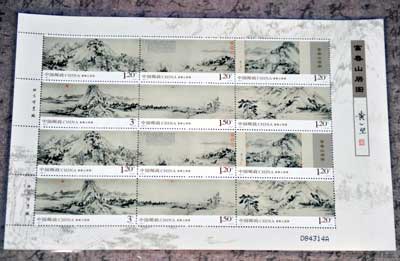A classic's road to reunion
|
A series of special stamps with the now-divided painting "Dwelling in the Fuchun Mountains." [Global Times] |
A series of special stamps with the panoramic image of Chinese classic landscape painting "Dwelling in the Fuchun Mountains" was released Saturday in the city of Fuyang in Hangzhou, Zhejiang Province, celebrating the first step in a possible reunion of the two parts of the painting, which are currently being separately housed on different sides of the Taiwan Straits.
Xu Wenguang, secretary of Fuyang Municipal Party Committee, said at the launch ceremony that the stamp represents a long-cherished wish that the precious work could one day be reunited and the two separated parts exhibited in Fuyang.
Famous landscape painters from both sides of the Straits, including Lin Jinzhong, Cai You and Luo Zhenxian from Taiwan and Feng Yuan and Sun Yong from the Chinese mainland attended the ceremony and together held a 15-meter-long replica hand roll of the classic work that they painted together.
The original 6.369-meter long, 330-centimeter high hand roll "Dwelling in the Fuchun Mountains" was created by famed Yuan Dynasty (1206-1368) painter Huang Gongwang (1269 - 1354) in his later years. The work took four years to complete and was considered one of the painter's representative works.
Vividly depicting the beautiful scenery in early autumn along the banks of the Fuchun River in Hangzhou, the painting is deemed to contain the highest level of traditional Chinese landscape painting techniques and is widely regarded as one of the 10 most precious surviving traditional Chinese paintings.
With a history of over 600 years, the painting has endured its share of suffering as it has been avidly pursued by both art enthusiasts and opportunists alike. At the end of Ming Dynasty (1368-1644) it went to Wu Hongyu, an art collector, who loved the hand roll so much that he made his family burn it before his death so that it would stay with him forever.
Fortunately Wu's nephew broke from the group watching the work burn and rescued the painting from the fire at a crucial moment, but it had already been burnt into two parts. The first part, which was only half a meter long, was renamed The Broken Mountains and is now kept at Zhejiang Provincial Museum in Hangzhou; the other piece was originally housed at the Palace Museum in Beijing and was taken to Taiwan in 1948 when the Kuomintang was defeated. It is currently kept at the Palace Museum in Taipei.
 0
0 







